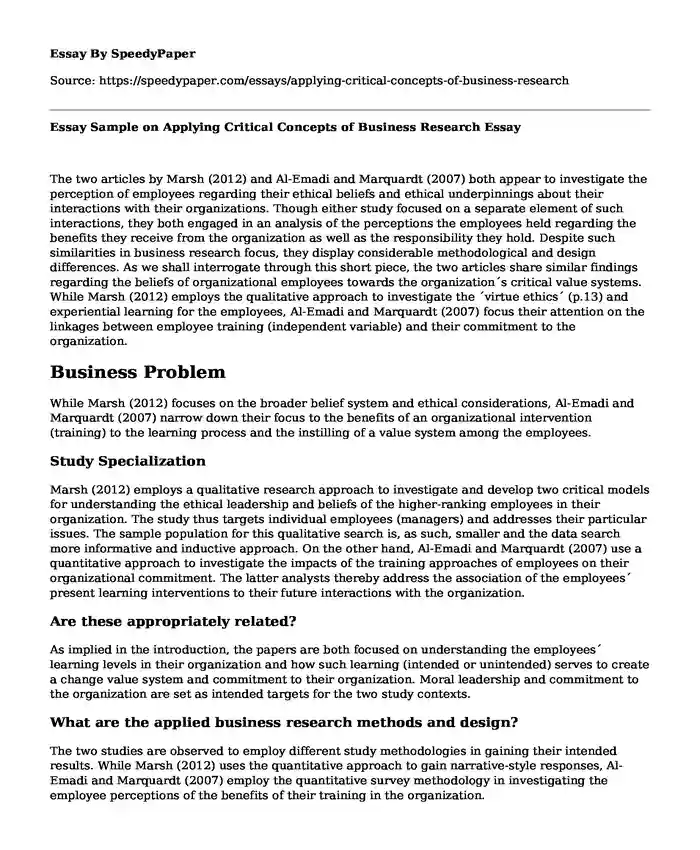
| Essay type: | Problem solution essays |
| Categories: | Human resources Business Research Problem solving |
| Pages: | 4 |
| Wordcount: | 853 words |
The two articles by Marsh (2012) and Al-Emadi and Marquardt (2007) both appear to investigate the perception of employees regarding their ethical beliefs and ethical underpinnings about their interactions with their organizations. Though either study focused on a separate element of such interactions, they both engaged in an analysis of the perceptions the employees held regarding the benefits they receive from the organization as well as the responsibility they hold. Despite such similarities in business research focus, they display considerable methodological and design differences. As we shall interrogate through this short piece, the two articles share similar findings regarding the beliefs of organizational employees towards the organization´s critical value systems. While Marsh (2012) employs the qualitative approach to investigate the ´virtue ethics´ (p.13) and experiential learning for the employees, Al-Emadi and Marquardt (2007) focus their attention on the linkages between employee training (independent variable) and their commitment to the organization.
Business Problem
While Marsh (2012) focuses on the broader belief system and ethical considerations, Al-Emadi and Marquardt (2007) narrow down their focus to the benefits of an organizational intervention (training) to the learning process and the instilling of a value system among the employees.
Study Specialization
Marsh (2012) employs a qualitative research approach to investigate and develop two critical models for understanding the ethical leadership and beliefs of the higher-ranking employees in their organization. The study thus targets individual employees (managers) and addresses their particular issues. The sample population for this qualitative search is, as such, smaller and the data search more informative and inductive approach. On the other hand, Al-Emadi and Marquardt (2007) use a quantitative approach to investigate the impacts of the training approaches of employees on their organizational commitment. The latter analysts thereby address the association of the employees´ present learning interventions to their future interactions with the organization.
Are these appropriately related?
As implied in the introduction, the papers are both focused on understanding the employees´ learning levels in their organization and how such learning (intended or unintended) serves to create a change value system and commitment to their organization. Moral leadership and commitment to the organization are set as intended targets for the two study contexts.
What are the applied business research methods and design?
The two studies are observed to employ different study methodologies in gaining their intended results. While Marsh (2012) uses the quantitative approach to gain narrative-style responses, Al-Emadi and Marquardt (2007) employ the quantitative survey methodology in investigating the employee perceptions of the benefits of their training in the organization.
Rationale of Studies
Both studies intended to improve employee engagement with their work and promote employee loyalty and commitment to the organization´s value system (Al-Emadi and Marquardt, 2007; Marsh, 2012). Promoting ethics and organizational value systems among employees are often recognized as the most crucial components of the organization´s success. Such a focus on training and value-instilment among personnel allows organizations to improve their outcomes.
Marsh (2012) bases her analysis on the foundational research of authors such as Gini (1998), Pollard (2005), and Quinn (2004). From such business research scholarly pieces, the analyst develops a framework for ethical leadership perspectives and develops two fundamental models of understanding such aspects. Al-Emadi and Marquardt (2007), on the other hand, mainly refers to the work by Kontoghiorphes and Bryant (2004), which they recognize as the most crucial literature groundings for analyzing organizational employees and research over the past three decades.
Purpose of the Study
While Marsh (2012) intended to determine the role of ethical leadership among the top-level managers, Al-Emadi and Marquardt (2007) aimed to investigate the part of training on the development of value systems and development of an increased commitment to their organization. In both instances, the authors successfully aligned the presented problems with the purposes of the overall studies.
Ethical Protections Required in Applied Business Research
Both studies centered their focus on management-level employees. As such, they ensured that the ethical requirements and the future-focused intentions of the study´s outcomes were sufficiently clarified for the target populations.
Foundational Theories and Concepts Frameworks
While Marsh (2012) focused on ethical leadership, Al-Emadi and Marquardt (2007) focused on organizational commitment through training. Methodologically, the studies employed qualitative and quantitative approaches, respectively. Marsh´s review used the comparative study methodology while Al-Emadi and Marquardt (2007) employed a descriptive statistical design for the analysis.
Bibliography
Al-Emadi, M. A. S., & Marquardt, M. J. (2007). Relationship between employees' beliefs regarding training benefits and employees' organizational commitment in a petroleum company in the State of Qatar. International Journal of Training and Development, 11(1), 49–70. https://doi.org/10.1111/j.1468-2419.2007.00269.x
Gini, A. (1998). Moral leadership and business ethics. In J. B. Ciulla (Ed.), Ethics: the heart of leadership (pp. 27–45). Westport, CT: Praeger.
Kontoghiorphes, C. and Bryant, N. (2004), Exploring employee commitment in a service organization in the health care insurance industry. Organizational Development Journal, 22(3), 59–74.
Marsh, C. (2013). Business executives' perceptions of ethical leadership and its development. Journal of Business Ethics, 114(3), 565-582. http://dx.doi.org.library.capella.edu/10.1007/s10551-012-1366-7
Pollard, B. (2005). The heart of a business ethic. Lanham, MD: University Press of America.
Quinn, R. (2004). Building the bridge as you walk on it: A guide for leading change. San Francisco: Jossey-Bass
Cite this page
Essay Sample on Applying Critical Concepts of Business Research. (2023, Oct 24). Retrieved from https://speedypaper.com/essays/applying-critical-concepts-of-business-research
Request Removal
If you are the original author of this essay and no longer wish to have it published on the SpeedyPaper website, please click below to request its removal:
- Free Essay Sample on Life Work Balance
- Free Essay Example: To Be Wise in Consuming Psychological Research
- Rock types
- Maya Angelou and Alice Walker - Free Essay
- Essay Sample on Transforming Theory to Practical Application
- The Pursuit of Ignorance - Free Paper Example
- Danielle McGuire's "At the Dark End of the Street." - Essay Sample
Popular categories




